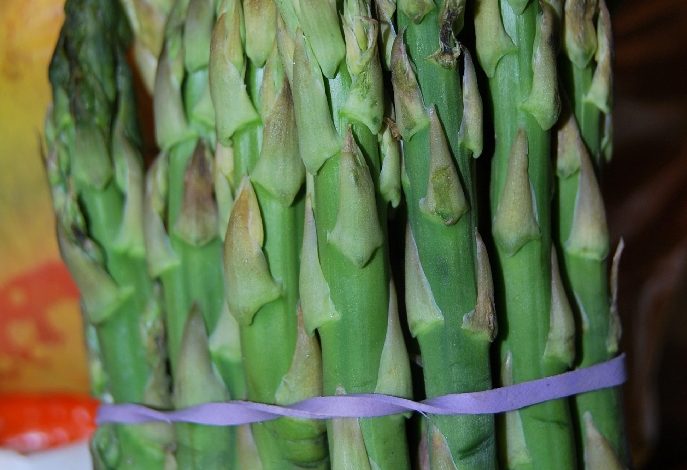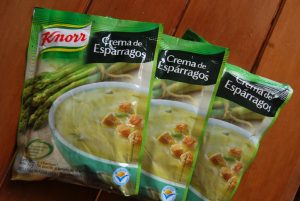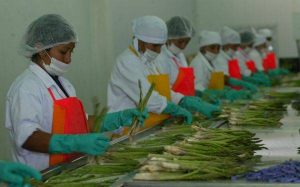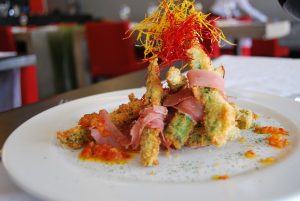Peru Exports More Asparagus than any Other Country

Peru is to asparagus these days what Saudi Arabia is to oil. It is the world’s leading exporter of the delight of spring. Yet, strangely, almost none of that bounteous crop is used in Peru, even though you can find asparagus on the menus of fine restaurants in Cuzco and elsewhere. This paradox demands an explanation.
Most restaurants offer a cream of asparagus soup on their menu, and so you might be surprised at how little of Peru’s asparagus crop is consumed nationally. While there are restaurants that make their own delicious cream of asparagus soup, many take the short cut of relying on the popularly promoted packaged soup. You can never be sure which they are doing unless you are knowledgeable and can tell the difference between the result of the industrial dried soup mix and a freshly made cream soup based on new green spikes.
The packages of dried soup may be the most consumed asparagus product in the country, even though Peru exports more asparagus than any other country. While China produces more, it does not export as much. Most of its asparagus crop finds its way into woks throughout that large country.
Asparagus is simply not a historical food that has entered into Peru’s gastronomy with vigor and vitality yet. In part, this is because the asparagus industry is relatively new.

Asparagus does not find itself poking its tendril skyward with the start of spring in small, campesino fields throughout the country. Instead it is an agroindustrial crop grown on the Peruvian coast.

The United Nation’s Food and Agriculture Organization notes that this industry began in the Virú Valley of coastal Peru in the 1950s, begun by a single family. They exported their crop in cans, mainly to Denmark.
With the agrarian reform of the 60s and the guerrilla wars of the 80s and 90s the industry only expanded fitfully. At the same time, however, it explored new means of export, as preserved product and as white asparagus.
However, with the peace that came to the country in the 90s and the development of market oriented land and economic policies an industry dedicated mostly to exporting fresh, green asparagus began to develop and thrive.
This expansion developed due to United States policies making funding available for crops that might remove the impetus for the production of coca and cocaine in Peru and from local families with capital developed in other industries, such as pharmaceuticals, mining and fisheries, who wished to diversify their investments. It also developed because of the experience and infrastructure found in Peru due to long experience with the export of cotton and other products.
While asparagus is grown in many regions of the coast, its production is concentrated in Ica and La Libertad, where more than 80% of the production occurs.
Peru’s coastal climate, with its lack of large temperature variations throughout the year has enabled a different regime for growing this food than is found in other major producers such as China, the United States, and Europe. In these others, fresh asparagus from local production is almost entirely available only in springtime.

Asparagus is the shoot of the asparagus plant that rises above the ground when the ground warms and days lengthen in northern climes. As the plants grow, tendrils expand outward to form fine leaves and it grows to become a large plant. The harvested part is only those first shoots whether as green asparagus, which are exposed to light, or white asparagus, shoots hidden from light.
The Peruvians worked with researchers in California to develop a plant adapted to the nature of Peru’s coastal valleys where the main limit on growth is the availability of water and not temperature.
As a result, by controlling water, Peru has developed a production that is strong from September through December and from January to June. The main part of its harvest corresponds to fall and winter in northern climes when there is no asparagus production, though demand for the crop is high.
Furthermore, Peru as other competitive advantages. It is able to obtain the highest yields of any exporting country for its crop. And it has relatively low labor costs, given that asparagus requires lots of hand work in harvesting and processing the fresh plant in order to maintain quality.
While Peru specialized in the export of fresh asparagus, it also produces packaged, canned, and frozen asparagus.
While the US consumes the majority of Peru’s exports of asparagus, the Andean national also exports to Europe and, surprisingly, to China.

Nevertheless, the internal market for asparagus remains woefully underdeveloped. Still green stems of asparagus appear in Cuzco’s markets when production is high. Restauranteurs look for good asparagus as part of the competitive creativity to take Andean produce and make high quality food for locals and travelers.
As a result, when asparagus appears in the markets, it quickly claims place on menus of fine eating establishments throughout the city, even if the food has yet to naturalize itself on the tables of local families, other than as a packaged soup. Despite being the Saudi Arabia of asparagus, the dawn of eating asparagus has yet to happen in Peru.
Sources and References:
Geoffrey Cannok, Peru and China as competitors in world markets: The Asparagus case. FAO, 2011.
Luz Díaz Rios, Agro-industries characterization and appraisal: Asparagus in Peru. FAO, 2007




